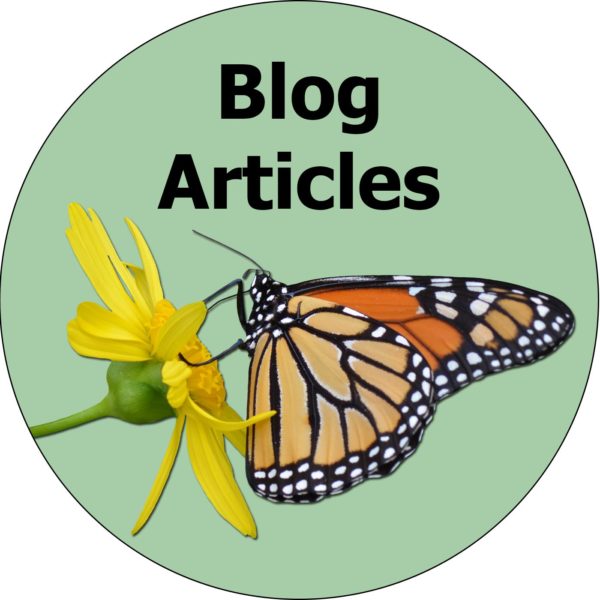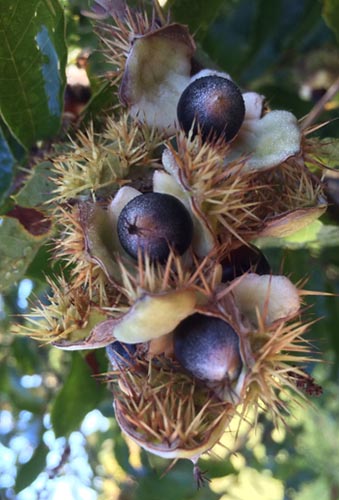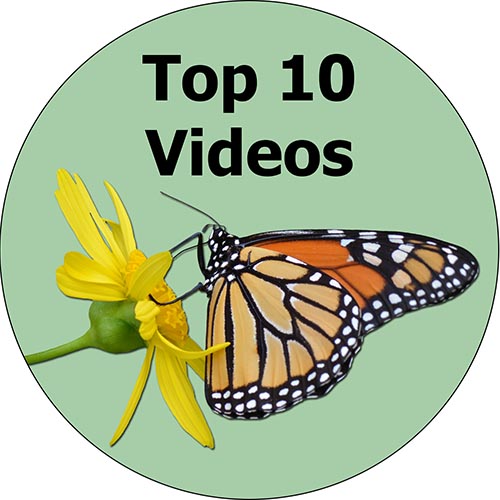
I always like to do roundups of the top 10 blog articles and top 10 podcast episodes at the end of every year because I know how easy it is to miss stuff. Sometimes we have the best intentions to go back and read or listening to something, but other things come up and then we forget. So, it can be helpful to have a reminder at the end of the year for some of those articles that we might have missed.
This year, creating the top 10 lists for the blog articles and podcast episodes was a little more complicated than it has been in years past because of a change I made this summer. When I started the Backyard Ecology blog and podcast, I envisioned the blog articles as being primarily tips or how-tos and profiles of plants and animals, while the podcast episodes would be primarily conversations with other experts in the field.
In my mind, they were two very different things – each one making more sense in the format that I chose for it. And since I switch back and forth between reading articles and listening to podcasts, I kind of assumed that everyone else did too. I know. That wasn’t the smartest assumption I’ve ever made, but we all fall victim to assuming that everyone else does things like we do.
Anyway, I’ve realized just how wrong that assumption was. The people who read my blogs were often interested in the podcast conversations but didn’t like listening to podcasts so they would skip them. Likewise, my podcast listeners were often interested in topics I covered in my blog articles but never found time to read the articles. And those are the best-case scenarios. Often, those who read the blog articles didn’t know the podcast existed and vice versa. You can’t make a choice about something if you don’t even know the choice exists.
So…. to better serve everyone and make the Backyard Ecology blog and podcast as accessible as possible to the greatest number of people, this summer I started recording the new blog articles and transcribing the conversations from the new podcast episodes. That way everyone can read or listen to all the content. Doing that, makes figuring out the top 10 lists a little trickier, but I think it’s worth it.
For the purposes of this year’s top 10 blog articles, I defined a blog article as one that I wrote as a tip or species profile – something that was just my voice – and usually containing multiple pictures to support the article. I chose the top 10 that were published between October 1, 2022 and October 1, 2023 based on the number of website views.
So, here are this year’s top 10 Backyard Ecology blog articles. Some of them were written later in the year so have audio recordings available, while others were published earlier in the year so don’t have recordings available.
10) Sometimes Life Happens
This was a heartfelt story relating an incident that happened to us back in June. I shared it because I know how easy it is to feel overwhelmed and to get discouraged when things don’t go as planned or take longer than you thought they would. My hope was that peeling back the curtain and showing some of the struggles that Anthony and I were dealing with might be encouraging to others who were also struggling with unexpected challenges. Sometimes it just helps to know we’re not alone and aren’t the only ones dealing with these types of things.
9) Cloudless Sulphur Butterfly: A Common Fall Migrant
This article was a profile of the cloudless sulphur butterfly. I love watching these bright yellow butterflies. Cloudless sulphurs can be found in most of the eastern U.S., although they aren’t as common north of Kentucky. One of the things that makes cloudless sulphur butterflies so special is that they are one of our migratory butterflies. I commonly see them in November around here and occasionally will see one on a warm day in early December if the weather has been relatively mild.
8) 5 Tips for Attracting Butterflies to Your Yard
As a group, butterflies are probably one of the most popular types of insects. It seems like everyone loves them and wants to attract them to their yards. In fact, many people are first introduced to gardening with native plants through their love of butterflies and their desire to attract more butterflies to their yard. So, to help you achieve that goal, I offered 5 simple tips for attracting butterflies to your yard.
7) Downy Woodpecker: Our smallest woodpecker and a common backyard visitor
Downy woodpeckers are the smallest woodpecker in North America and can be found throughout most of the country. If you enjoy watching birds on your property, then you’ve probably seen them because downy woodpeckers are common visitors to yards and feeder. In fact, this was the second species of woodpecker that I learned to identify as a kid because it was such a common visitor to our feeders. In this article, I provide a profile of downy woodpeckers and how to attract them.
6) Allegheny Chinquapin: An underutilized but excellent nut producing shrub
Anthony wrote this article to give me a little extra time to work on some behind-the-scenes projects. The Allegheny chinquapin or dwarf chestnut is a native nut producing shrub that can be a great option for yards but is often underutilized. In this article, Anthony describes the shrub’s biology, life history, uses by pollinators and wildlife, and how to best incorporate it into your landscape. Just as a side note, he also has a video on this topic if you’d rather watch a video than read an article.
5) Why Are Some Native Plants Unavailable Early in the Season?
As the weather starts to warm up in the spring, many of us experience the same symptoms – the gardener’s itch. We want to play in the dirt and plant our entire garden. The nursery centers overflowing with all kinds of blooming plants only makes the symptoms worse. But, as native plant gardeners, it isn’t always possible to plant everything as soon as the weather warms up in the spring. Some of the species that we want to add to our gardens may not be available until late spring or maybe even the fall. I talk about why that’s the case in this article.
4) Native Ground Nesting Bees: Important Early Season Pollinators
Did you know that approximately 70% of the bee species that are native to North America are ground nesting bees? (Note: We’re not talking about yellow jackets. Those are wasps.) Many of our native ground nesting bees are active in the very early spring – sometimes before the trees fully leaf out. We have a colony on our property that is always active in March. These species have a fascinating life cycle, much of which is spent underground and out of sight. In this article, I talk about ground nesting bees, their importance, and what to do if you have them on your property.
3) Spicebush – A Native Shrub with Plenty to Like
Spicebush is a shrub that is native to much of the eastern U.S. It is one of our early blooming shrubs with the flowers appearing before the leaves. In the fall, the female plants have beautiful red fruits. In this article, Anthony talks about the biology and life history of the spicebush, its value for pollinators and wildlife, and how to incorporate it into your yard.
2) Wildflower vs Native Plant: What’s the Difference?
Some of the terminology associated with growing native plants can be confusing, especially when you are first getting started. It doesn’t help when people use different words interchangeably, even if they really aren’t the same things. Or when a word can mean different things to different people. “Wildflower” and “native plants” are two terms that definitely fall into those categories. I wrote this article to try to clear up some of that confusion or at least raise awareness about the potential for confusion.
1) 5 Things to Consider Before Buying or Putting Up a Bat Box
More and more people are interested in attracting bats to their neighborhoods. That makes me very happy because bats are such an important part of the ecosystem, and many species are facing serious population declines. Bat boxes are a common tool that people use to try to attract bats to their properties. In this article, I talk about some of the things you should consider before buying or putting up a bat box.
Those are the top 10 Backyard Ecology articles that I published between October 2022 and October 2023, but my most downloaded article of all time isn’t among them. I’ll share that article with you as a bonus.
Bonus: Most downloaded Backyard Ecology blog article of all time
Bluets: Delicate Blue Flowers of Spring
Common bluets (a.k.a. Quaker ladies or azure bluets) are tiny blue wildflowers that are native throughout most of eastern North America. They bloom in the spring and in some places can create a carpet of low growing, dainty blue blossoms. In this article, I talked about their biology, life history, importance to pollinators, and how to incorporate them into your yard.
I hope you enjoyed that roundup of the most popular Backyard Ecology articles over the past year. If you haven’t found the Backyard Ecology podcast or Backyard Ecology YouTube channel yet, I encourage you to check them out as well.

Backyard Ecology: Exploring Nature in Your Backyard
Nature isn’t just “out there.” It’s all around us, including right outside our doors. Hi, my name is Shannon Trimboli, and I am the host of Backyard Ecology. I live in southcentral Kentucky and am a wildlife biologist, educator, author, beekeeper, and owner of a nursery specializing in plants for pollinators and wildlife conservation. I invite you to join me as we ignite our curiosity and natural wonder, explore our yards and communities, and improve our local pollinator and wildlife habitat. Learn more or subscribe to my email list at www.backyardecology.net.

